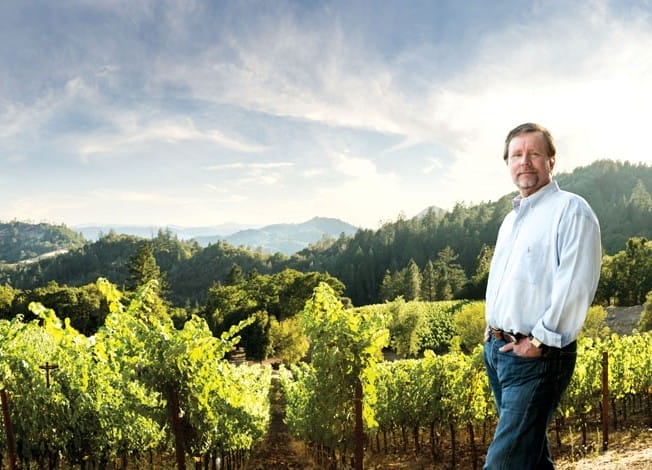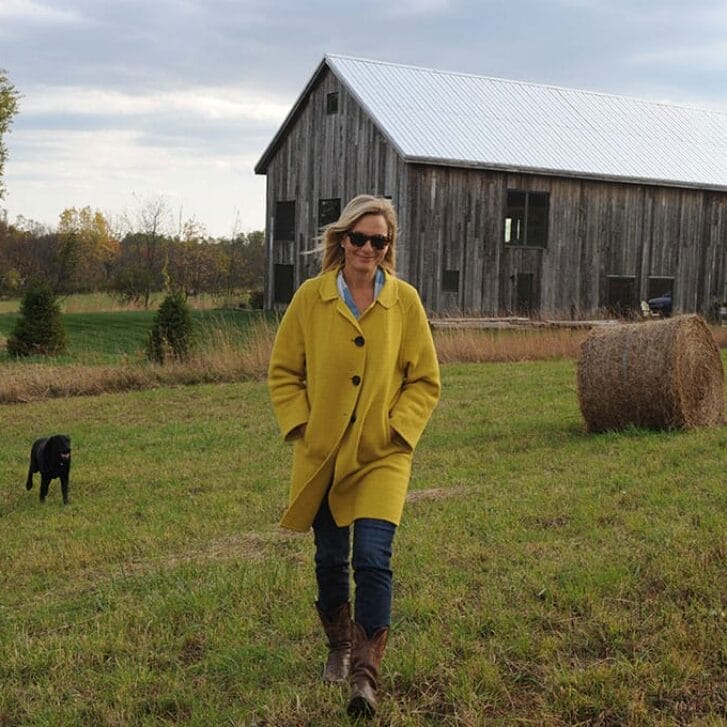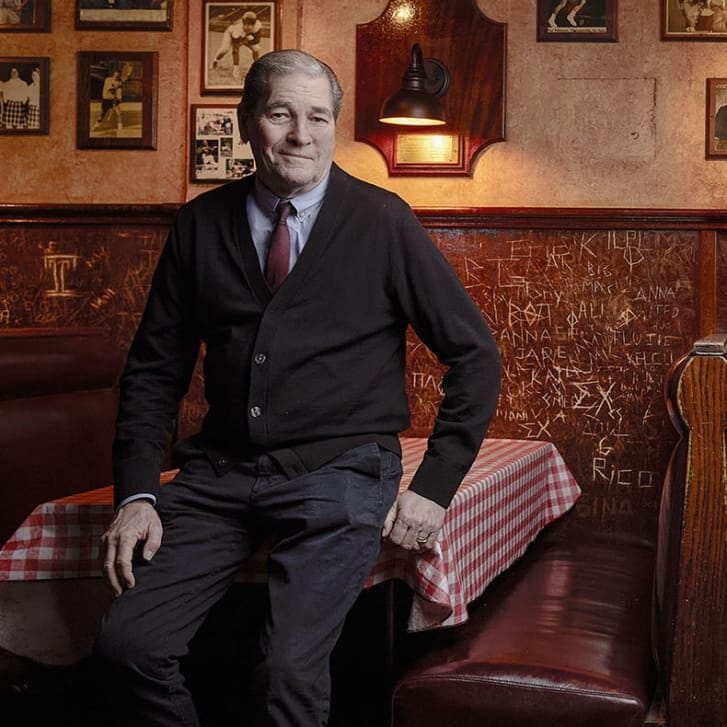The real wine life is better depicted by a meeting at a wholesaler off an alleyway of New Rochelle, NY, where José Manuel Ortega Gil-Fournier, W’89, C’89, stands before a roomful of salespeople and sells his dream like a defendant pleading his case. It is a warehouse stacked with thousands of his competitors’ cases, and he knows there doesn’t have to be room for his. It is sweating on a wooden bench in a three-track train station waiting for a reporter, on a morning after he barely slept because of jet lag and that dinner (the second of the night) he had with another reporter in Manhattan. It is hoping he will catch the flight that afternoon back to Argentina so he will not miss his one-time meeting with Neil Martin, the oenophile tapped by Robert Parker to succeed him as Wine God of the New World, followed by another meeting with a possible investor.
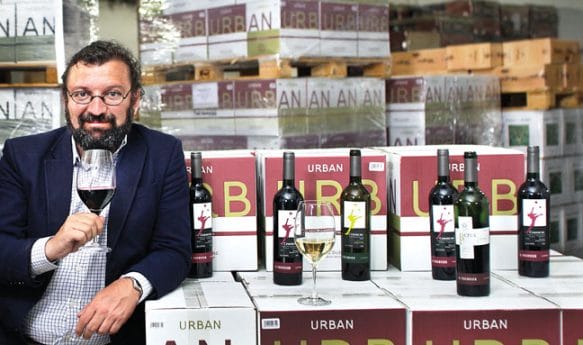
Jose Manuel Ortega Gil-Fournier, W’89, C’89, and product in a wholesaler’s warehouse. Photo credit: Michael Pares.
All the while, Ortega labors to ensure the sun rises the next morning on his vines, but he is never sure.
Ortega, a Spaniard with grace despite his convoluted itinerary, is stoic when he talks about the wine life. He has traveled to 75 countries for his O. Fournier wine group and spends 280 days per year on the road. He works dawn to dusk seven days a week to survive in this economy.
Did he not leave the world of finance and heart attack risk for a wine lifestyle?
Yes, but being a vintner is tough work. “This lifestyle that I decided to take on has incorporated incredible sacrifices and bad moments,” Ortega says. “It has not been easy for us. It’s not sort of like an Alice in Wonderland.”
Anthony Hamilton-Russell, WG’90, a former banker at Morgan Stanley and consultant at Bain, knows the pressures of the corporate environment, but his current occupation has roughed him up too.
“It’s a deeper, slower form of stress,” he says. “We live on the factory floor … it’s kind of with you all the time.”
Hamilton-Russell apparently felt the stress as soon as he joined Hamilton Russell Vineyards in 1991. After what he terms a “premature midlife crisis” at 29, he left London to return to his country of birth, South Africa, to help his father, who had owned the winery as a passion and hobby since 1975.
“It traditionally washed its own face—just,” Hamilton- Russell says, who wanted to turn it into a real business, a fulfilling career and a way to pay his family’s bills.
“I took a major, major cut and lifestyle redesign,” he says.
— READ THE SIDE STORY: TASTING FOR TWO TYPES OF WINE DRINKERS —
Inner Judgment
Hamilton-Russell’s first task: apply sober objectivity and business sense. He turned over nearly the entire staff, focused the business on the two wines they could produce best (pinot noir and chardonnay), and stopped making the nine they could not.
“That kind of surgery was fairly easy,” he says. What progressed over the next 20 years has not been.
“Anybody who gets into the wine business gets really hit by this … how genuinely complicated a business it is,” he says. “It really is not easy.”
Plenty of smart businesspeople have failed in wine-making, and many wine enthusiasts cannot handle the business aspects.
It requires an “inner judgment” about so many facets of the business, says Hamilton-Russell, from raw agriculture to the “absolutely finessed” winemaking, to the packaging and “intensive” marketing, to the finance of a capital-intensive operation and the management of a diverse workforce.
Jim Knighton, WG’84, G’85, even dares to say that he isn’t sure that his Wharton MBA meant anything in his operation of Napa Valley-based Knighton Family Vineyards. He launched the venture in 2004 after originally buying property above Calistoga, CA, as a weekend getaway. He has yet to make money from it but feels strongly that it is finally moving in that direction.
“It really is interesting. I did all the MBA qualitative and quantitative analysis, I talked to everybody. I used all of those Wharton skills,” he says, and yet he missed all of his cash-flow assumptions and underestimated the time it takes to establish a brand and launch a super-premium product during a massive global recession. Getting off the ground had cost nearly twice as much as originally estimated.
But before you wonder if Knighton is taking a tipple from his limited-release, $100-a-bottle cabernet, he recalls how his Wharton knowledge and his overall business sense have kept him going.
When he discovered the 50 acres, abandoned vineyard and old barn in his attempt to escape the fog and chill of San Francisco’s Sunset District, he had the sense to hire a skilled, local consultant, who told him the ground was “absolute premier” earth for Napa’s top grape, King Cab. He admits to knowing little about wine going in—and barely drinking the stuff—so he looked for a more expert opinion, to Napa’s grape growers trade group and its vintners’ association, where he got some names of “very highly respected winemakers.” They offered him a deal: They would plant out his land for 25 years at no cost to him, give him some grapes in return and keep the rest for themselves.
He then knew he had something. So he politely told them to go pound grapes on their own properties.
Knighton produced his first crop in 2006, which he sold to the reputable Ramey Cellars. In 2007, another premium winery, Vineyard 29, offered a more expansive deal. Knighton’s MBA came out again, and he negotiated instead to sell his grapes under certain conditions, including that they produce two proprietary barrels of wine for Knighton in 2007. His decision was to grow slow, mitigate the risk and own it all. The first vintage of the wine turned out so good that Knighton decided to start his own private label.
“We held our breath and sent it to Robert Parker at Wine Advocate,” he says.
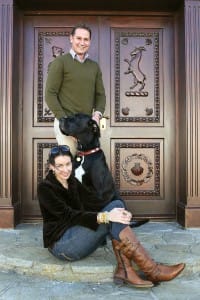
Anthony Hamilton-Russell,WG’90, and wife Olive
Blending Strengths
Ortega came to winemaking after a means-to-an-end career in banking and private equity at Banco Santander and Goldman Sachs. He spent years studying and investing in bottles until he deduced he could do the business better. In December 1999, he brought his sister and brother-in-law and two technical experts to Argentina to investigate properties. He found one in the Uco Valley outside Mendoza. In May 2000, he bought it and placed his sister and her husband in charge. In 2001, his father joined as an investor. He has since opened operations in Spain and Chile.
As the O. Fournier wine group’s history unfolds, you see Ortega’s business genius emerge. From the start, he knew that he was not very good at day-to-day management.
“I’m actually very lousy. It’s a bit boring for me,” he says. And though he is learning, he knows enough about winemaking to know to stay out of it. “That’s why I have winemakers. They do their thing, I do mine, I focus on selling the wines, promoting the wines, creating new projects,” Ortega explains.
He is the strategist. His business intelligence can be distilled into a few crucial maneuvers early on in O. Fournier’s development: to split his production across three countries to both hedge against the risk of a bad vintage in one region as well as against exchange rates, to plant the right grapes for those regions, and to grow the business to a “critical mass” with a more mass-market brand (Urban) that can pay for his high-end brands (such as O. Fournier and Alpha Spiga) and provide the cash flow to pay for traveling those 280 days marketing around the world. You can count on two hands the winemakers that produce multiple labels in multiple countries.
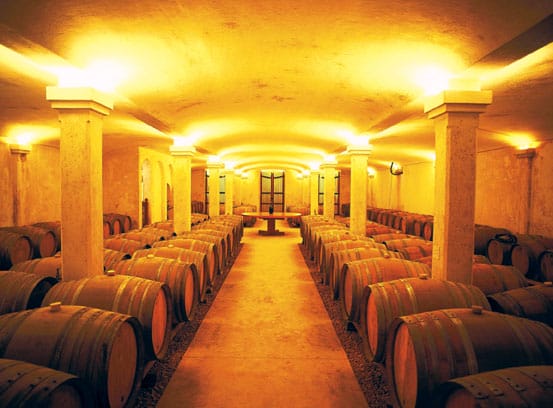
The Hamilton Russell Vineyards pinot noir maturation cellar and (below) its cellar and tasting room.
Ortega’s latest creative push comes in the form of his Wine Partners Program—which affords outside investors the chance to buy a plot of land on the O. Fournier estate in Argentina, grow grapes and produce wine, all for an initial outlay of $150,000. In three months of marketing, at last count when we interviewed him in late July, Ortega had sold $2 million worth.
“We’re making it for the more common man, to be able to have the pleasures of owning a vineyard and making wine. So that in that respect, it’s first of all innovative, and also touches a segment of the market that no one is touching,” he explains.

Beyond business education and training, then, perhaps it takes a natural entrepreneurial spirit to succeed in the business. Ortega’s is a blend from both his family lineages. His mother’s family is the Fourniers of centuries-old, playingcard- manufacturing fame. His father’s father was also a man of independent action, and Ortega credits him as his “guiding light”—a man who left for Brazil after the Spanish Civil War, returned to his family after five years to start a business and find success in real estate.
“I decided to start my own business because I didn’t want to continue with his business,” Ortega says, citing a stat that 80 percent of family businesses are “burned” by the third generation. “I didn’t want to burn my grandfather’s business, so I wanted to start a business to get my grandchildren to burn my business.”
Ortega views O. Fournier as a real contribution to local economies, the world’s palate and his family’s well-being.
“I have created something that is real, that is tangible, that you can touch. You can see a building, a beautiful building, a beautiful wine, things that go beyond my life here on earth,” he says.
Hamilton-Russell also is expressing his need to run and grow his own business through the grape. Consider as evidence his explanation for why he’s bought up neighboring land: to have something to sell off (if needed) in bad times besides his core business, but to also have separate, non-competing entities to bequeath his four children.
And Knighton? The vineyard is but one of his businesses. His ability and inclination to buy his Napa property came about because of a successful business transaction in biotechnology in the late ’90s that sent him into “semiretirement.” Within a year of starting the vineyard in 2004, after becoming bored, he launched a biotech firm called AvidBiotics.
Let’s be honest. All three men also expressed a drive toward pre-eminence that you would expect from Wharton graduates no matter their profession.
— READ THE SIDE STORY: INNOVATING OFF THE VINE —
Ego Dividend
For all their ambition, grit and heavy lifting, the success of these three Wharton winemakers has not been guaranteed because of another confounding risk in winemaking that we have yet to mention: the idiot factor. Vintners the world over will roll their eyes and repeat the clichéd joke about the best way to make a small fortune in the business. Start with a large fortune. But there are too many people in the business all too happy to make this a truism. Ortega describes them as those who seek an “ego dividend” on their wineries.
“A large percentage of your competitors if you’re on the top end of the market aren’t in it to make money,” Hamilton- Russell says of people using vast wealth accumulated elsewhere and applied to wine production as a “vanity project.”
They contribute to the vast and growing number of wineries out there. “It doesn’t matter if its recession or not. They just keep opening up,” the South African says.
Despite the competition, all three Wharton winemakers have distinguished themselves in the market.
Remember that first vintage that Knighton sent to Wine Advocate? Parker scored it 90+, and the 2010 barrel sampling received a 93+, reports Knighton, whose distribution list for his 200 cases of cab is well oversubscribed.
Hamilton-Russell’s wines have earned nearly every distinction possible for a South African vineyard—including best South African white for chardonnay and best pinot in the world at an international competition—while the firm has seen 20 times increase in revenues and “a hell of a lot more in profit” from a vineyard that looks the part of heaven on earth.
“Wine production needs to be thought of less as a sensible business and more as an aesthetic pursuit. With successful hard work, it becomes a self-financing lifestyle. And the beauty of this lifestyle is what encourages numerous new entrants each year,” he says. “It is an extraordinarily stimulating life, with fascinating problems across a full range of disciplines. You live close to nature, travel to beautiful places, eat in the best restaurants, drink the best wines and meet very large numbers of interesting people from all over the world. In over 21 years, I don’t think I have ever been bored by my work.”
With its $8 million in sales, Ortega’s company has also garnered its share of recognition, like 94 Parker ratings for its O. Fournier Syrah 2002, O. Fournier Ribera de Duero 2005 and O. Fournier Maule 2008. The architecture of his winery in Mendoza, at the foot of the Andes, has even earned distinction.
“When I won best Argentinian wine trophy at the largest wine conference in the world, I started crying like a baby, but it’s sort of the realization of all the hard work, all the investment, all the effort, all the planning,” Ortega says.
Perhaps the wine life is not so bad after all.




















